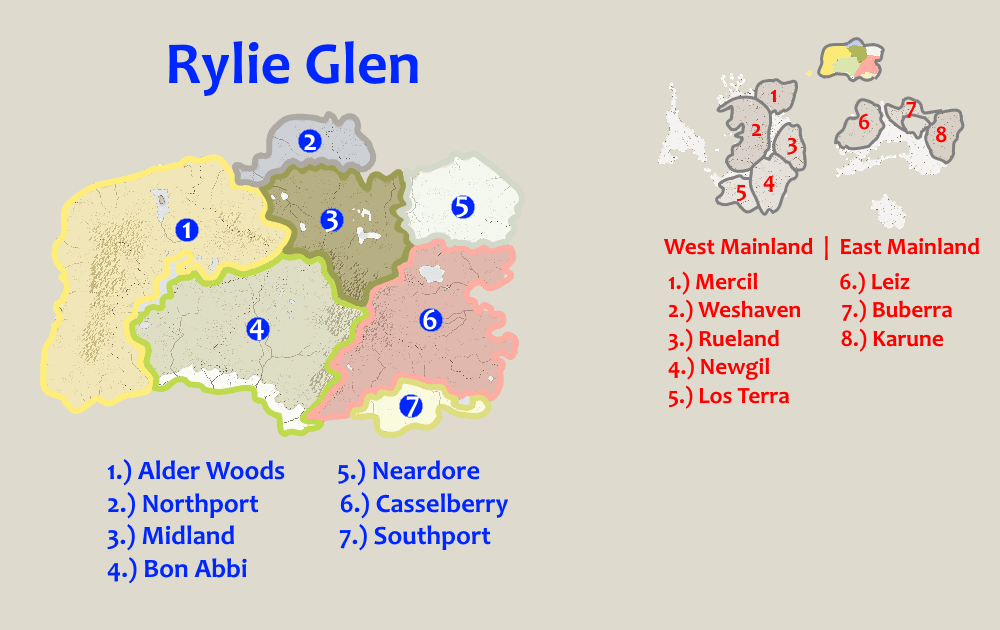The Islands
A millennia ago, Middle Earth experienced the ‘Great Divide’. A series of tectonic activities separated large lands to formed ‘Middle Earth North.’ There were two large islands, West and East Mainland, and a smaller island to the North called Rylie Glen.
Families over time populated these islands. Some stayed during this tumultuous period, while others sailed to various locations. People of similar cultures gravitated towards a specific city, ruled by landowners. These were ‘Nobles’.
The cities of West Mainland included Mercil, Weshaven, Rueland, Newgil, and Los Terra. Those on East Mainland were Liez, Buberra, and Karune. Cultures remained isolated because of the various mountain ranges. But each developing their own unique set of skills.
Mercil, known for its ability to build tall ships, was the first to identify shipping lanes to each city. Ruelanders, gifted builders, assisted in creating ports for each of the cities. Buberra hosted artisans, especially those working with metals.
Newgil harvested fresh and saltwater fish. Karune mined their caves. Los Terra produced skilled warriors. Weshaven remained a mystery.
It’s unclear how the ‘common language’ developed. With increased shipping activity, most cities adopted the language out of necessity. Most cities stopped using their native tongue, forgotten by the next generation.
Discouraged by the isolation, Lord Lydal Henry Rylie decided to do something. He explored the smaller northern island north of the Mainlands. During one trip, his young son ‘Glen Mark’ fell overboard, lost in the stormy seas. Lord Lydal never recovered. He named the island as ‘Rylie Glen’ in tribute to his son.
Convincing the Casselberry family to join him, together, they established the first farm. Lord Lydal brought new families to the island, which form the first city, Casselberry.
Over time, more families migrated to Rylie Island. Pushing further North and West, Lord Lydal established two more cities. These were Neardore, and Midland. His vision of a place where all seven cultures would blend was coming true.
His final accomplishment was Bon Abbi, a safe haven city. People fleeing the Noble system, or escaping from indentured service found protection here. Those making it to Bon Abbi found freedom.
To protect each city, Lord Rylie drafted an agreement. He wanted to make sure they would not revert back to isolation. The agreement had simple rules:
- Borders for each city were never to change.
- Each city ruled as they thought best.
- The next generation of nobles would take the mantel and continue to rule.
- If the ruling family line in a city doesn’t continue, the largest city was to appoint a ruler.
- The last surviving ruling family had the option to claim all cities under their rule. But Bon Abbi was to always remain
free unless no Noble family was willing to rule. - Then, the last remaining noble family would rule the island.
All ruling families signed the Covenant of Agreement. While traveling north around the island, Lord Lydal’s ship sank during a winter storm. His dreams of blending all cultures were now in the hands of those ruling families.
The cities grew as expected, a model for the rest of the Mainlands. Many of the nobles from Liez moved to Casselberry. They became the elites, with little connection to the commoners.
When the last Casselberry heir passed away, another city had to appoint a new ruling family. This task fell to Neardore, a ‘sister’ city that was a reflection of Casselberry. The Robion family became the new rulers, voted by the nobles residing in the two cities.
The Robions knew nothing about agriculture. So, they transitioned from agriculture to commerce, in a few years. They built Southport to host merchant ships and store their goods in warehouses.
Merchants paid for the privilege of selling on the island. Casselberry enforced tariffs where possible, building significant wealth. With the largest population on the island, the Robion family expanded the city.
They built a city square where nobles shopped the latest fashions. Merchants who paid their tariffs were allow to sell their wares. The Robions established a court system to handle tariffs and fines. Merchants and commoners alike appeared before the various courts. The Council of Nobles presided over each court.
Lord Edmund Orlo


